| Previous :: Next Topic |
| Author |
Message |
KarlK
Member


Joined: 18 Jun 2009
Posts: 584 | TRs | Pics
|
 |
KarlK
Member
|
 Wed Nov 09, 2022 2:29 pm |
|
|
The Monument Creek trail # 484 begins from the Harts Pass road about seven miles NW of Mazama, courses NE alongside the Lost River, and in about four gently undulating miles reaches Eureka Creek near its confluence with the Lost River at ~2600’elevation.
For seekers of a genuine wilderness experience, the realm N of Eureka Creek will "give it to you good and hard" (hat tip to H.L. Mencken). For climbers ticking off Washingon's 100 highest peaks, three (Lake Mountain, Monument Peak and Blackcap Mountain) are situated between the terminus of Eureka Creek and the creek's headwaters near Shellrock Pass; the main challenge, though, is just getting to the part where you start climbing.
For hikers, seekers of mythical forest denizens, backcountry fisherman, or for lunacy-adjacent backpack hunters, the trail along Monument Creek NE of Pistol Pass affords a banquet of wilderness and wildlife splendor rich with creatures large and small. This is a place where wild things abound and fortune favors audacity and preparation.
Therefore, the long-abandoned section of trail between the Eureka Creek crossing and Shellrock Pass represents a worthy target for reopening. This constitutes a major challenge of the sort that attracts hardy non standard-issue gals and guys afflicted with a penchant for heavy load carrying, extensive crosscut saw work and abundant experience with the phenomenon of "beware what you wish for."
Eureka Creek typically runs too swift and deep until late July or August for safe wading, posing for many years a chilly and potentially lethal ford for earlier season hikers. This problem stemmed from flooding on or about May 15, 2008, which washed out the stock bridge (https://www.nwhikers.net/forums/viewtopic.php?t=7967052&highlight=eureka+ck+bridge).
 Copy of original stock bridge from the link above -- the truss increased susceptibility to washout 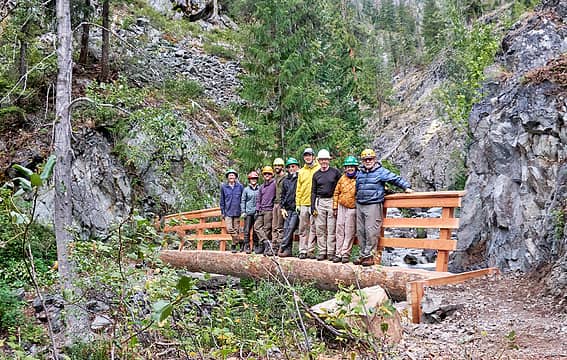 All rights reserved (Joe Hofbeck photo); L to R: Nate, Baily, Conner, Allen, Steve, Dave, Dianne and Joe Hofbeck, a modest sampling of all the people who have contributed to this project 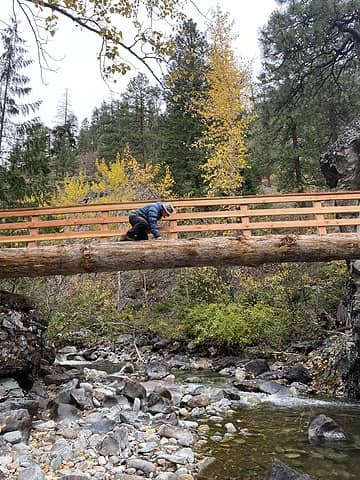 Joe H working on the bridge -- bottom of bridge is ~2-3 ft higher than former truss bridge, making it resistant to washout. 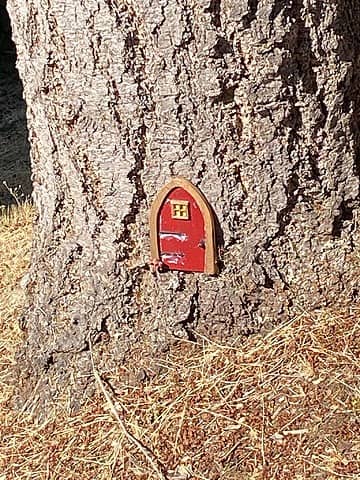 Magic Trail Elf Door  Felling the donor log, Oct 12, 2021  Yeah, looks hopelessly manky but just you wait 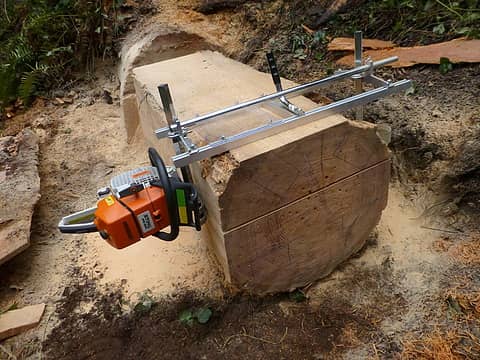 Milling boards for bridge lumber - note layout on log end 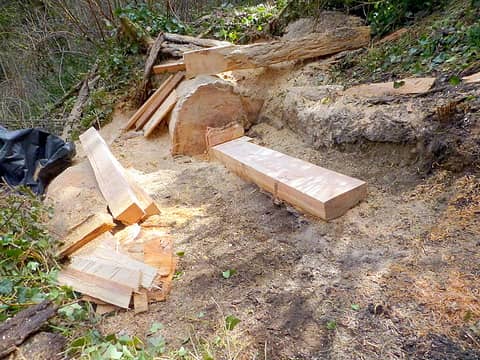 Milling progress - tough on chainsaw bars! 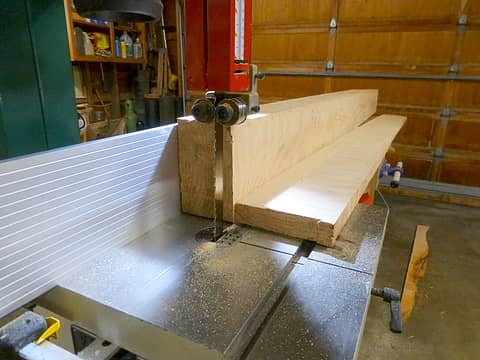 Bandsaw phase 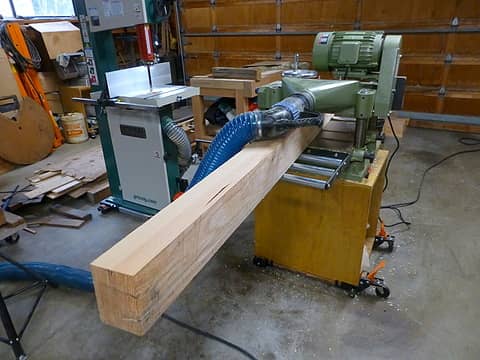 Planing phase 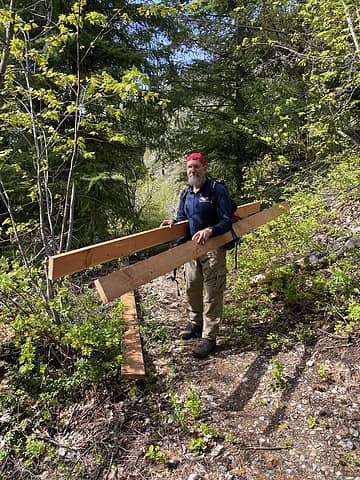 KarlK, AKA Not-a-Horse, packing boards in May. 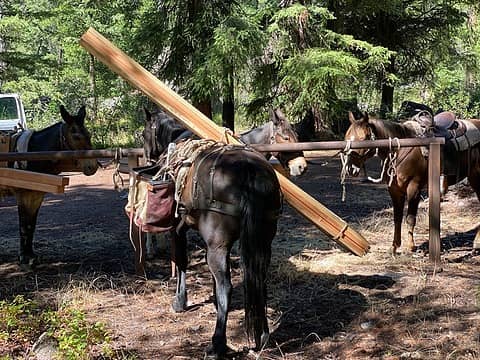 Horse packing boards  All rights reserved (Joe Hofbeck photo); retired Seattle Firefighter and dauntless Trail Fixer DonH 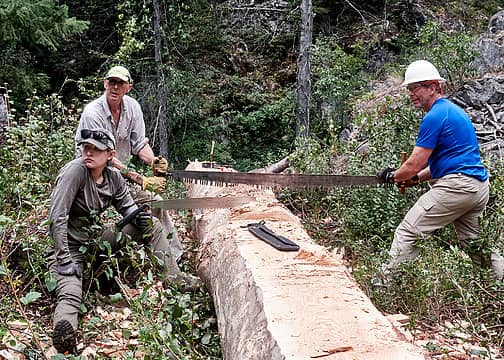 All rights reserved (Joe Hofbeck photo); Bailey, DaveS and DonH 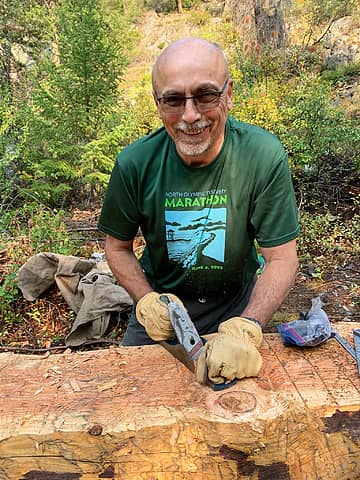 All rights reserved (Joe Hofbeck photo); SteveG 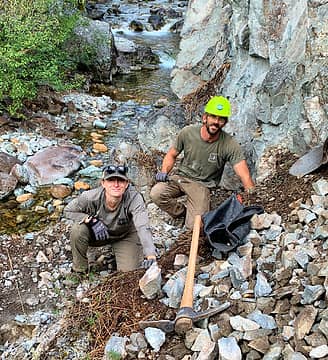 All rights reserved (Joe Hofbeck photo); Rachel and AllenJ 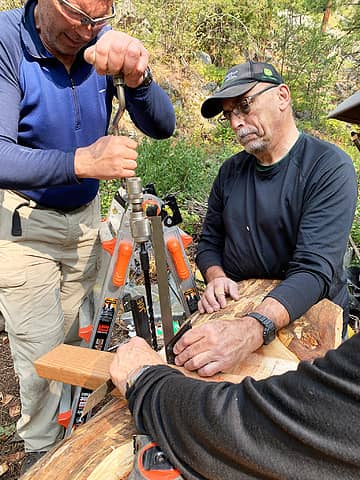 All rights reserved (Joe Hofbeck photo); DonH and SteveG hand drilling holes 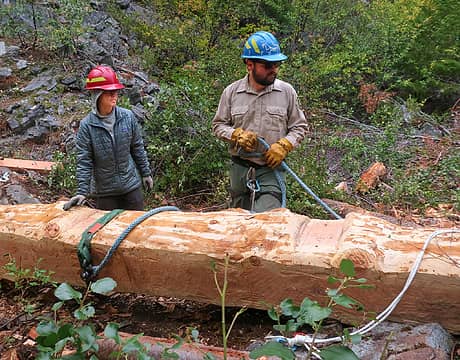 All rights reserved (Joe Hofbeck photo); Bailey and LandonD log wrangling 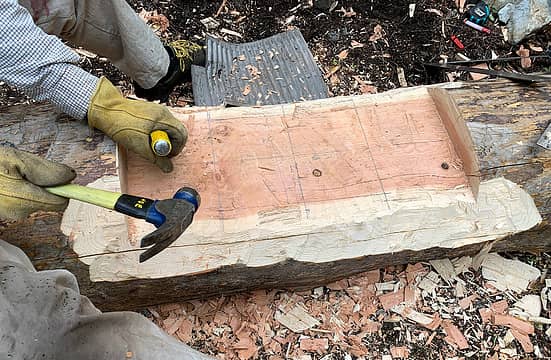 All rights reserved (Joe Hofbeck photo); Lots of woodworking 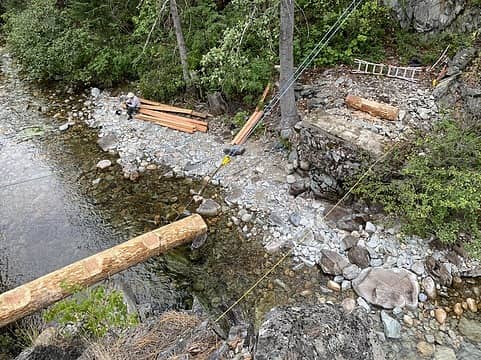 Yarding footlog into place  ABS shim installation, Nov 1, 2022
Karl J Kaiyala
 Walkin' Fool, vk, Nancyann, snowshoeman, wallorcrawl, lopper, Eric Gilbertson, Bronco, Brushbuffalo, rubywrangler, Prosit, JimK, RichardJ, Slim, runup, Bramble_Scramble, Now I Fly, raising3hikers, Waterman, brewermd, Opus Walkin' Fool, vk, Nancyann, snowshoeman, wallorcrawl, lopper, Eric Gilbertson, Bronco, Brushbuffalo, rubywrangler, Prosit, JimK, RichardJ, Slim, runup, Bramble_Scramble, Now I Fly, raising3hikers, Waterman, brewermd, Opus  Alden Ryno, rstoddard24, geyer, awilsondc, RichP Alden Ryno, rstoddard24, geyer, awilsondc, RichP  fourteen410 fourteen410
Karl J Kaiyala
 Walkin' Fool, vk, Nancyann, snowshoeman, wallorcrawl, lopper, Eric Gilbertson, Bronco, Brushbuffalo, rubywrangler, Prosit, JimK, RichardJ, Slim, runup, Bramble_Scramble, Now I Fly, raising3hikers, Waterman, brewermd, Opus Walkin' Fool, vk, Nancyann, snowshoeman, wallorcrawl, lopper, Eric Gilbertson, Bronco, Brushbuffalo, rubywrangler, Prosit, JimK, RichardJ, Slim, runup, Bramble_Scramble, Now I Fly, raising3hikers, Waterman, brewermd, Opus  Alden Ryno, rstoddard24, geyer, awilsondc, RichP Alden Ryno, rstoddard24, geyer, awilsondc, RichP  fourteen410 fourteen410
|
| Back to top |
  
|
 |
Kim Brown
Member


Joined: 13 Jul 2009
Posts: 6899 | TRs | Pics
|
This is a great project, wonderful photo essay to know how it's done, and what hard work it is. And the Hofbeck Fund is cool.
"..living on the east side of the Sierra world be ideal - except for harsher winters and the chance of apocalyptic fires burning the whole area."
Bosterson, NWHiker's marketing expert
"..living on the east side of the Sierra world be ideal - except for harsher winters and the chance of apocalyptic fires burning the whole area."
Bosterson, NWHiker's marketing expert
|
| Back to top |
  
|
 |
RichP
Member


Joined: 13 Jul 2006
Posts: 5634 | TRs | Pics
Location: here |
 |
RichP
Member
|
 Wed Nov 09, 2022 3:05 pm |
|
|
A thousand thanks to you all.
 Now I Fly Now I Fly
 Now I Fly Now I Fly |
| Back to top |
  
|
 |
brewermd
Member


Joined: 02 Jun 2008
Posts: 159 | TRs | Pics
|
 |
brewermd
Member
|
 Wed Nov 09, 2022 3:19 pm |
|
|
Thank you all for all of the hard work!
|
| Back to top |
  
|
 |
Stefan
Member


Joined: 17 Dec 2001
Posts: 5093 | TRs | Pics
|
 |
Stefan
Member
|
 Wed Nov 09, 2022 4:57 pm |
|
|
|
| Back to top |
  
|
 |
Bowregard
Member


Joined: 05 Feb 2019
Posts: 562 | TRs | Pics
Location: Sammamish |
Thanks for all the hard work and dedication.
Just curious - Does anybody happen to know anything about the design load criteria for a footbridge like this? I see 9 people standing on it and I am sure it is super stout but I just got to wondering what loading conditions they might design for. I would think snow loading would be fairly straightforward but it is essentially a one lane bridge. Do they assume multiple people would get on at the same time and do they introduce a factor to account for degradation of the wood over a specific period of time? It just strikes me as somewhere between a group of hikers pushing a log over a creek for passage and a city footbridge project and makes me wonder.
|
| Back to top |
  
|
 |
fourteen410
Member


Joined: 23 May 2008
Posts: 2629 | TRs | Pics
|
Thank you! I'm curious - how do you determine what makes a good donor tree for a log bridge, other than length/height?
|
| Back to top |
  
|
 |
KarlK
Member


Joined: 18 Jun 2009
Posts: 584 | TRs | Pics
|
 |
KarlK
Member
|
 Wed Nov 09, 2022 7:19 pm |
|
|
That's a teriffic question Bowregard. The Forest Service does publish design criteria for backcountry bridges that basically ensures that bridges are overbuilt, and Joe Hofbeck spent considerable time making sure that the footlog bridge design and execution complied with those criteria. Joe's a first class structural engineer who takes this stuff very seriously. The FS had one of their engineers vet the design, and Landon (the MVRD trails manager -- very solid guy) felled a Doug fir that nicely met the specs. Doug fir is terrific construction wood. You'll also note that the log is arched upward a bit, which adds considerable strength.
I'll check with Joe for more details.
Karl J Kaiyala
 Bowregard Bowregard
Karl J Kaiyala
 Bowregard Bowregard
|
| Back to top |
  
|
 |
Bowregard
Member


Joined: 05 Feb 2019
Posts: 562 | TRs | Pics
Location: Sammamish |
KarlK - Thanks so much for the prompt reply. I will have to look for the published design criteria. My education was ME so I am not familiar with bridge design issues but of course the physics is the same. I noticed the fir tree which is stronger than Cedar albeit with less bug/rot protection. It is great to see the cooperation with the FS, trails, and work crews. I was a bit shocked at seeing the guys with a handsaw to take down that tree but I bet that was fun in a way too. I find your comment about the slight arch adding considerable strength to be interesting. I was taught that a slight rise in beam bridges had very little effect on strength (and can be ignored for the purpose of analysis) though it is wise to build with a rise to reduce the visible effect of any deflection.
|
| Back to top |
  
|
 |
iron
Member

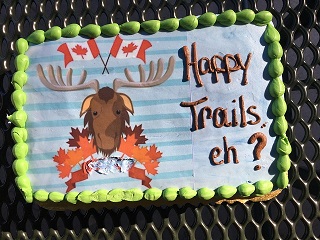
Joined: 10 Aug 2008
Posts: 6392 | TRs | Pics
Location: southeast kootenays |
 |
iron
Member
|
 Wed Nov 09, 2022 9:56 pm |
|
|
| Bowregard wrote: | | KarlK - Thanks so much for the prompt reply. I will have to look for the published design criteria. My education was ME so I am not familiar with bridge design issues but of course the physics is the same. I noticed the fir tree which is stronger than Cedar albeit with less bug/rot protection. It is great to see the cooperation with the FS, trails, and work crews. I was a bit shocked at seeing the guys with a handsaw to take down that tree but I bet that was fun in a way too. I find your comment about the slight arch adding considerable strength to be interesting. I was taught that a slight rise in beam bridges had very little effect on strength (and can be ignored for the purpose of analysis) though it is wise to build with a rise to reduce the visible effect of any deflection. |
(structural engineer here):
i just did a super crude calc making some assumptions.
assume the tree is 24" diameter, and spans 40ft. taking a very conservative 100psf live load (hard to do, see image below), the factor of safety is 1.6. this also assumes a crappy wood of 900psi, but you're likely more in the 1500psi territory which would increase FOS to 2.6. further, if you assume 60psf live load, with 1500psi wood, then you're at FOS = 3.5
camber of a beam has no impact to strength. it's just visual appearance for user comfort. if you had a true arch, with buttresses supporting the ends (think roman aqueduct), then you turn your arch into a compression-only member, which is essentially a column, not a beam. that's not what's going on here. any arch of a natural tree has zero impact on strength.
(note: i barely do calcs anymore, am on about 3 hours of sleep, and speak in metric now, so take this all with a grain of salt)
 wallorcrawl, Brushbuffalo, Bowregard wallorcrawl, Brushbuffalo, Bowregard
 wallorcrawl, Brushbuffalo, Bowregard wallorcrawl, Brushbuffalo, Bowregard |
| Back to top |
  
|
 |
Kim Brown
Member


Joined: 13 Jul 2009
Posts: 6899 | TRs | Pics
|
Seems an arch allows some give for snowload. Granted, it's a narrowish log, but heavy snow is heavy snow. But I studied literature, so there's that..... 
"..living on the east side of the Sierra world be ideal - except for harsher winters and the chance of apocalyptic fires burning the whole area."
Bosterson, NWHiker's marketing expert
"..living on the east side of the Sierra world be ideal - except for harsher winters and the chance of apocalyptic fires burning the whole area."
Bosterson, NWHiker's marketing expert
|
| Back to top |
  
|
 |
Bowregard
Member


Joined: 05 Feb 2019
Posts: 562 | TRs | Pics
Location: Sammamish |
Thanks Iron,
That answers a bunch of my questions (and good to know my memory is not as foggy as I feared). Sounds like you guys load it the same way we used to load an airfoil surface - psi/psf. I guess that makes sense although I agree it would be hard to imagine 55 people on that bridge ( (200plf x 40ft)/145lb = 55 people ). Your comments regarding slight camber vs true arch (and camber being for visual appearance) are consistent with what I remember from school.
I pretty much stopped doing calcs for work 25 years ago. Funny how it was a royal PITA back then but I kind of enjoy when I have a reason to do it now.
Anyway - thanks for the info
 Brushbuffalo Brushbuffalo
 Brushbuffalo Brushbuffalo |
| Back to top |
  
|
 |
Pyrites
Member


Joined: 16 Sep 2014
Posts: 1884 | TRs | Pics
Location: South Sound |
 |
Pyrites
Member
|
 Thu Nov 10, 2022 1:54 am |
|
|
| Bowregard wrote: | | KarlK - Thanks so much for the prompt reply. I will have to look for the published design criteria. My education was ME so I am not familiar with bridge design issues but of course the physics is the same. I noticed the fir tree which is stronger than Cedar albeit with less bug/rot protection. It is great to see the cooperation with the FS, trails, and work crews. I was a bit shocked at seeing the guys with a handsaw to take down that tree but I bet that was fun in a way too. I find your comment about the slight arch adding considerable strength to be interesting. I was taught that a slight rise in beam bridges had very little effect on strength (and can be ignored for the purpose of analysis) though it is wise to build with a rise to reduce the visible effect of any deflection. |
I knew someone who was construction superintendent for the monorail. He talked of the designers’ concern with deflection being noticeable by riders. Of course the load on the span changes rapidly. There was some arch added just for purpose you describe. Concern was that passengers would notice difference at piers. I want to say there was some addition at piers, shims(?), after trials. On reflection I think there was material added, with taper out from piers. This may have been intentionally thickened at pour, and ground down after trial with a taper. This would have been as a boy sitting between two men driving up the Cariboo in 1971. Place your own +/- on accuracy of memory. Hope not total diversion. Should have built some arch in topic.
PS. At time I thought monorail construction was a long time ago. I was surprised these old guys still remembered details. Of course I’m well older than they were then and I remember something of it fifty years later.
Keep Calm and Carry On?
Heck No.
Stay Excited and Get Outside!
Keep Calm and Carry On?
Heck No.
Stay Excited and Get Outside!
|
| Back to top |
  
|
 |
Sculpin
Member


Joined: 23 Apr 2015
Posts: 1383 | TRs | Pics
|
 |
Sculpin
Member
|
 Thu Nov 10, 2022 9:24 am |
|
|
| iron wrote: | | camber of a beam has no impact to strength. it's just visual appearance for user comfort. if you had a true arch, with buttresses supporting the ends (think roman aqueduct), then you turn your arch into a compression-only member, which is essentially a column, not a beam. that's not what's going on here. any arch of a natural tree has zero impact on strength. |
Mechanical engineer here. KarlK was right about the slight arch giving added strength, where the word "strength" refers to a reduction in the magnitude of downward deflection when the beam is loaded in the middle.
The arch in the tree adds nothing to the tensile strength of the log, if that was what was meant. But it most certainly aids in carrying live load.
If an array of load and deflection sensors were placed across the span, it would be obvious how the compressive load vectors pass though more wood in an arched structure than a straight log, effectively increasing the thickness of the log with respect to deflection under bending. (Wish I had the IT savvy to diagram this.) In a straight beam, the bending load caused by a weight in the middle resolves to a tensile component on the bottom in the middle, as well as at both ends. This is accompanied by a compressive load on the top in the middle. When you put an arch into the beam, the vector path of the compressive load passes through more wood, putting more of the live load into compressing the beam rather than stretching it. This will always cause a decrease in downward deflection and increase the magnitude of the load required for failure of the beam. That means it is "stronger." It is not intuitive, but that is how it works.
FWIW, Wikipedia agrees. "A camber beam is much stronger than another of the same size, since being laid with the hollow side downwards, as they usually are, they form a kind of supporting arch."
Between every two pines is a doorway to the new world. - John Muir
Between every two pines is a doorway to the new world. - John Muir
|
| Back to top |
  
|
 |
KarlK
Member


Joined: 18 Jun 2009
Posts: 584 | TRs | Pics
|
 |
KarlK
Member
|
 Thu Nov 10, 2022 9:26 am |
|
|
|
| Back to top |
  
|
 |
|
|
You cannot post new topics in this forum
You cannot reply to topics in this forum
You cannot edit your posts in this forum
You cannot delete your posts in this forum
You cannot vote in polls in this forum
|
Disclosure: As an Amazon Associate NWHikers.net earns from qualifying purchases when you use our link(s). |